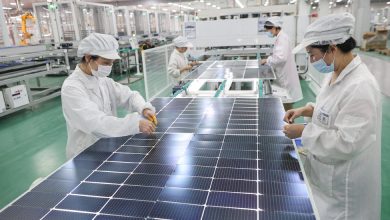Examining the Role of Climate Change in a Week of Wild Weather

Hurricane-force gusts in nine states. Immense dust storms in Colorado and wind-fanned wildfires in Kansas. The first-ever December tornadoes observed in Minnesota and western Iowa. Temperatures soaring past 70 degrees in cities like Omaha and Des Moines, a record.
The powerful storm that swept through the Midwest on Wednesday was extraordinary in many respects, with 100 million Americans under some form of weather alert.
“We’ve not seen that combination of heat and dry, followed by an extended period of strong wind,” said Grady Dixon, who teaches geosciences atFort Hays State University in Kansas. “It was so unusual for the month of December — it has to make you ask questions.”
One key question is what role global warming might have played in fueling such an extreme weather event. Scientists cautioned that it could prove difficult, if not impossible, to untangle the precise links between this week’s storm and climate change, although it appeared to be helped in part by record warmth across much of the country.
And there is evidence that the United States can expect more unusual severe storms as the planet heats up, potentially striking in new places or at unexpected times of year. While some questions are difficult to answer — such as whether that will mean more tornadoes in the future — scientists say the risks of increasingly wild weather make it all the more urgent that cities and states take steps to protect people and property.
“We do expect an increase in favorable conditions for severe storms,” said John Allen, an associate professor meteorology at Central Michigan University. “And that means we have to be aware that we can have these extreme events in places or at times that we haven’t necessarily thought of before.”
Two key ingredients for severe storms are warm, moist air creating updrafts and wind shear, a change in wind speed and direction that can allow storms to become stronger. But storms also need a trigger to form, such as a hot day or a cold front, which can be somewhat more unpredictable, Dr. Allen said.
Some studies have concluded that as global warming advances, driven by the burning of fossil fuels, favorable conditions for severe storms in the United States will increase this century. The increase is expected to be more pronounced during cooler seasons that don’t traditionally see as many thunderstorms, such as early spring, fall and winter, thanks to the presence of more warm, humid air during periods of higher wind shear.
Powerful Storms in the U.S.
Violent weather swept across the central and southern United States in mid-December, killing dozens and leaving a trail of destruction.
- The Aftermath: Maps, photos and drone footage capture the scope of the damage after a swarm of tornadoes struck the South and Midwest.
- When Warnings Don’t Help: Though scientists have become extremely successful at predicting tornadoes, ferocious winds continue to have deadly consequences.
- Personal Accounts: In Kentucky, a man played his piano as his home was destroyed, and two babies survived a tornado in a bathtub.
- How to Help: Volunteers and aid groups are mobilizing to help hard-hit areas. Here’s how to pitch in.
It remains less certain as to whether those increasingly severe storms might lead to more tornadoes. These complex events are harder to model, and so far there doesn’t appear to be clear evidence that, for instance, tornadoes have changed in frequency or intensity over the past 40 to 60 years.
Even so, scientists have seen some evidence that tornado behavior seems to be shifting: In recent years tornadoes seem to be occurring in greater “clusters,” and the region known as tornado alley in the Great Plains, where most tornadoes occur, appears to be shifting eastward.
There’s also the possibility that derechos — groups of intense and fast-moving wind storms like those that caused havoc in the Midwest on Wednesday — may shift into new regions or even become more common as the planet warms, particularly during cooler seasons where they haven’t traditionally been as common.
Derechos “are primarily a summer phenomenon,” said Harold Brooks, a senior research scientist at the National Oceanic and Atmospheric Administration’s National Severe Storms Laboratory. “If you make it more summery, you might expect them to increase.”
“The thing that makes derechos painful is that while their winds are frequently not strong enough to destroy buildings, they take out power lines and trees over a large area,” Dr. Brooks added. “Tornado paths may have intense destruction in the middle of it. In a derecho, it covers a much broader area.”
The week’s ominous weather shocked even professional weather watchers. Zach Sharpe, who heads the Iowa Storm Chasing Network, said he had never experienced such bizarre weather in December.
Much of Wednesday was unseasonably warm — “It felt like spring; there were people wearing shorts,” he said — but once the storm front approached, a blast of cold air brought instantly freezing temperatures and 80-miles-per-hour winds. “It was eerie to be chasing tornadoes 10 days before Christmas,” Mr. Sharpe said. “We were out in our vehicles, listening to Jingle Bells, while tornado sirens were going off.”
Still, scientists said, this week’s storm was so unusual and had so many different forces behind it, including a strong jet stream moving across the central states, that it can be difficult to disentangle the impact of global warming compared to other factors like La Niña, an intermittent climate phenomenon in the Pacific Ocean that can influence winter storms.
This storm was “about as messy an event as you can get,” Dr. Brooks said. “Is this a weird one-time event? Or maybe it won’t repeat for a long time? Will the seasonality change a lot? I don’t think we know.”
Victor Gensini, a professor of meteorology at Northern Illinois University, pointed out that all extreme weather events are now taking place against the backdrop of an atmosphere that has been profoundly shaped by humans burning fossil fuels. “Assume that all extreme weather events are impacted by climate change,” he said.
The better question is to what extent climate change might have enhanced the extreme weather event or how likely was the event to occur in the absence of climate change, he said.
Scientists have been able to answer those questions for numerous other extreme weather events, such as this year’s deadly heat wave in the Pacific Northwest or severe flooding in Germany and Belgium, by using computer models to determine if global warming made them more likely or worse. Whether any researchers try to do something similar for this week’s storm remains to be seen.
For some scientists, however, arguing about the precise role of climate change is only part of the story. Whether or not scientists ultimately settle on an answer, they say, society should do as much as possible to reduce vulnerability to extreme weather.
“We might not know exactly how climate change is going to affect tornadoes going forward, but we do know that there are lot of things we can do to protect people today,” said Stephen Strader, a disaster scientist at Villanova University.
For instance, he noted, many states in tornado-prone areas still aren’t doing nearly enough to strengthen and enforce building codes in ways that have been proven to save lives. And, while meteorologists have improved the accuracy of tornado warnings, there is still far more work that needs to be done in understanding how to make those warnings as effective as possible so that people take them seriously and get out of harm’s way.
“There are always two sides of the coin when it comes to disasters,” Dr. Strader said. “There’s the climate itself, but there’s also society vulnerability. We can work to address climate change, but we shouldn’t lose focus on what we can do today to improve survivability against these extreme events.”




